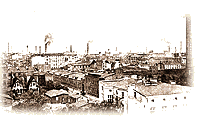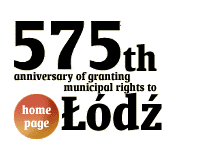|
The years between 1870-1890 are the period of most intense development of industry in the history of Lodz. Many big cotton plants come into existence, among others: I. K. Poznanski’s plant (in 1872) and also J. Heinzl’s and Kunitzer’s plant (in 1879). The production of woollen, linen, silk, and rubber goods as well as textile machines develops. At that period Lodz entered a phase of great capitalist development.
 The concentration of capital in a big textile industry caused serious changes in the form of possession but also in legal, and organisational structures. One-man businesses and general partnerships were converted into joint stock companies.
The area of the town was too small both for the mass of people to settle in Lodz and for a great number of new factories to be situated there (in 1908 the town with the population of 340 000 covered the same area as in 1840 when the number of population was only 13 000). The concentration of capital in a big textile industry caused serious changes in the form of possession but also in legal, and organisational structures. One-man businesses and general partnerships were converted into joint stock companies.
The area of the town was too small both for the mass of people to settle in Lodz and for a great number of new factories to be situated there (in 1908 the town with the population of 340 000 covered the same area as in 1840 when the number of population was only 13 000).
The shortage of building grounds resulted in extending the administrative boundaries of the town. The first suburbs appear: Baluty and Chojny which are the districts of poverty, built in a chaotic and primitive way, devoid of any municipal facilities.
The new class was arising and it started to create new conflicts. In Lodz of that time, the 19th century eventful history, people’s lifes, and the history of industry got mixed together.
Already in 1861 in Scheibler’s factory in Lodz, power looms were destroyed. Whereas in 1892 the first general strike on the Polish territories, known as “The Lodz Rebellion”, took place.
In the years 1905-1907 tens thousands of workers in Lodz started fighting for their rights again. As a result of violent encounters, several hundred of people were killed or injured, many of those who took part in the struggle were arrested.
Despite the crisis in the beginning of the 20th century, the number of population in Lodz increased up to 408 000 in 1910, and in 1913 – to 506 000. In 1906 the area of the town was extended to 38.1 sq. kilometres. Just before World War I, Lodz was one of the most densely populated industrial cities in the world (there were 13 280 people per sq. kilometre).
During World War I, the city was under German occupation. The war stopped the process of economic development, Lodz lost 43% of its inhabitants. The inter-war period was the time of depression in textile industry. The fact that in 1922 Lodz became the capital of the province did not change it as well.
| 


